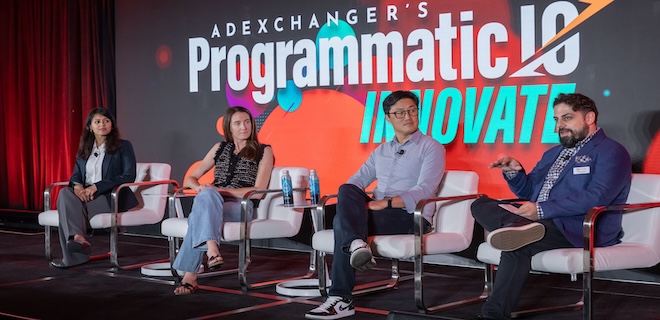 |
|||||||||
|
|||||||||
| Secrets from Sin City: A Publisher’s Dossier from Programmatic IO |
 |
| File 1: The Buy Side Secrets on Brand Safety Brand safety is no longer just about avoiding harmful content; it's about fostering meaningful, positive connections with consumers. Mark Proulx, global director, media quality and responsibility at Kenvue, said, “Brand safety has really expanded from just a checkbox to responsibility, quality, fraud, viability, emissions and attention.” This evolution moves the industry beyond rigid keyword blocklists toward AI-powered, semantic tools that can understand nuance and context. Rather than just protecting brands, these tools help them build mental availability and favorable associations in consumers’ minds. Inefficient blocking can lead to significant media waste, sometimes to the tune of millions of dollars. “We’ve been able to generate $4.2 million in cost avoidance,” Proulx noted, by reducing unnecessary blocked impressions. Traditional verification methods often fail to grasp the full context, leading to costly mistakes. To get the most out of every dollar, verification needs to be actively managed and continuously optimized. But publishers are no strangers to brand safety's stickiness. As Jana Meron, Strategic Advisor, Lioness Strategy, noted at Programmatic IO last year, “It’s time for both advertisers and publishers to face facts and stop letting fear dictate brand safety strategies.” File 2: The New York Times’ View on Curation According to Courtney Glaze, VP of revenue operations at The New York Times Advertising, publishers must treat curation as a strategic solution to post-cookie challenges. Glaze further emphasized that curation is about “solving for volume without relevance” by using first-party data and audience intelligence to create meaningful, targeted segments for marketers. It’s a way to enhance signal fidelity for buyers, enabling smarter, more effective targeting across curated marketplaces. But, Courtney noted, publishers lack consistent methodology, making it even more important to take a disciplined, audience-first approach. Glaze said this strategic mindset extends to how publishers value and package their inventory. The New York Times created its own hierarchy—prioritizing direct deals, premium PMPs, and finally, the open market—to ensure inventory is not undervalued or oversold. Instead, publishers must treat their inventory as a premium asset, using performance data to guide pricing and packaging decisions. Not all curation is created equal, and buyers often struggle to distinguish true value from simple repackaging. That’s why transparency, selective partnerships, and a deep understanding of one’s audience are essential. “Marketing and publishing objectives are aligned," Glaze said, and programmatic strategies must reflect that shared goal. File 3: The Challenger Platforms Google recently suffered a major legal setback with the DOJ's ruling, and other platforms are eager to take advantage of the programmatic opportunity. Challenger platforms create unique niches to compete with Google’s and Meta’s dominance. LinkedIn, Spotify and Reddit strategically differentiate themselves by leveraging their platform-specific strengths. Jae O., head of ad product, ads measurement at LinkedIn, emphasized the company’s B2B focus, highlighting how it targets professionals with precise audience insights. Chloe Wix, global head of product and commercial growth at Spotify, is expanding beyond audio to create more immersive advertising experiences through video and AI-generated content. Jyoti Vaidee, VP of ad product management at Reddit, points out that their platform offers unique reach, with 40% of conversations about products and services, and 30%-60% of users are not on other social platforms. Each platform invests heavily in AI to enhance targeting, improve ad creation and provide deeper insights, whether it’s LinkedIn’s professional graph, Spotify’s generative ad tools or Reddit’s community intelligence. The key theme emerging is the need for differentiation. These challenger platforms create value by offering more specialized, context-rich advertising environments. They’re addressing advertiser demands for transparency, privacy and performance by developing unique ad formats, leveraging first-party data and creating tools that make advertising more efficient and targeted. As Jae O. said, "it’s about providing not just reach but meaningful, measurable outcomes that go beyond traditional digital advertising approaches. Did you like this newsletter? Is there a topic you want me to tackle next time? Feel free to hit me up with your feedback at abyrd@admonsters.com. |
 |
| Monster Mashup |
| Amazon Joins the Prebid Party With Its Own Adapter Amazon announced Wednesday it’s building a dedicated Prebid adapter. The move signals that Prebid has firmly established itself as the industry standard. Read more. Why Attention Metrics Are Showing Up In The Financial Times’ RFPs Predictive attention is emerging as a signal of quality. Publishers like the Financial Times are already seeing it show up in RFPs—a sign it could become the next viewability benchmark. Read more. The Law Of Diminishing Returns In AI: When More Data Signals Don’t Mean Better Campaigns Here's the truth about data: while certain signals like weather patterns or real-time engagement metrics can significantly impact campaign performance, others merely add noise. Read more. The Power of Publisher-Direct Ad Campaigns While trust in national news continues to erode, often due to political bias or polarization, local and independent journalism remains a trusted cornerstone for communities, and a place for advertisers to connect with consumers. Read more. |
 |
||
|
||
 |
||
 |
||
|
| @{optoutfooterhtml}@ |





